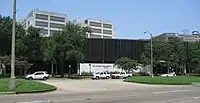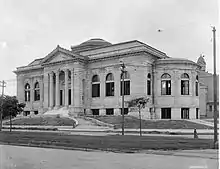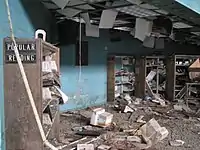The New Orleans Public Library (NOPL) is the public library service of the city of New Orleans, Louisiana, United States.

History

The system began in 1895 in the Fisk Free and Public Library in a building on Lafayette Square.[1] Abijah Fisk was a merchant who, over fifty years earlier, had left his house—at the corner of Iberville and Bourbon Streets—to the city for use as a library. Subsequent donations had resulted in libraries and collections not completely free and open to the citizenry. An 1896 city ordinance proposed by Mayor John Fitzpatrick combined the Fisk collection with a newer municipal library. It eventually became known as the New Orleans Public Library.
On January 18, 1897, the library opened its doors to the public. At that time the collection comprised over 35,000 volumes. A significant portion of the collection was obtained from the Fisk Free and Public Library and the Public School Lyceum and Library. The first librarian was William Beer who concurrently worked as a librarian at another library in New Orleans: the Howard Memorial Library.[1] Beer resigned from NOPL to focus on his work at the Howard Memorial Library in 1906. His successor was Henry Gill.[1]
A turn-of-the-20th-century donation of $50,000 from businessman Simon Hernsheim allowed the library to begin building a significant collection. In 1902 the city received $250,000 from Andrew Carnegie to build a new main library and five branches. By 1908, the new main library was open at Lee Circle and branches were open at Royal Street & Frenchmen in the Faubourg Marigny neighborhood, on Pelican Avenue in Algiers, and on Napoleon Avenue near Magazine Street uptown.[2] In 1911 and 1915, further Carnegie branches opened at 2940 Canal St and Dryades & Philip respectively.
By 2005, NOPL had a dozen branches in addition to a newer (1960) main library on Loyola Avenue. The branches included Algiers and Napoleon, mentioned above, although renamed.[3]
The main library is listed on the National Register of Historic Places as a contributing building in the New Orleans Lower Central Business District, as part of the district's 2006 expansion.
Effects of Hurricane Katrina

NOPL was severely impacted by Hurricane Katrina on August 29, 2005. Damage to branch locations ran from two windows broken at the Cita Dennis Hubbell Branch in Algiers to complete destruction of the Martin Luther King Branch in the heavily damaged northern section of the Lower 9th Ward. Photographs of branch building damage are available on the library's website.[3]
With the devastation of the city and the crippling of city government, NOPL was forced to lay off 90 percent of its employees.[4] All libraries were closed for over two months. The 19 remaining staff members, when they were able to re-enter the city, began surveying damage and salvaging assets.
Two branches—Hubbell and Nix (on Carrollton Avenue uptown)—reopened with limited services (no circulation) on 31 October 2005. Part of the Main Library also reopened. Damage to the NOPL system is estimated at $26–30 million.[5] Library administrators began looking for outside sources of funds to begin hiring additional staff.
Branches
From the four libraries in 1908, the New Orleans Public Library system continued to expand. In 2005, the system included three regional, three major and six neighborhood branches; as of 11 June 2008 the system had ten branches, including temporary branches.[3] By early 2017, there were fourteen branches open, with one additional branch scheduled to re-open in 2018.[6][7]
Former branches in the 20th century
From 1908 to 1959, the main branch was on Lee Circle; it was demolished after the opening of the current main branch. The Marigny Branch on Frenchmen & Royal at Washington Square, one of the original Carnegie Branch libraries, was severely damaged during Hurricane Betsy in 1965 and demolished. From 1915 to 1965 there was a Central City branch at Dryades & Philip Street, originally the main "Colored" library during the era of racial segregation. A former Mid-City branch was on Canal Street at Gayoso.

Summary of branch changes from 2005 to date
- Algiers Regional Branch, 3014 Holiday Drive, Algiers. Opened in 1966. Katrina damage: part of facade blew off two sides; wind-driven rain destroyed books and equipment; ceiling tiles fell; mold; closed indefinitely. A temporary library in a trailer was operated in the parking lot. Building demolished in 2010; a new larger branch library opened in summer 2012.
- Alvar Branch, 913 Alvar Street, Bywater neighborhood. A Works Progress Administration-built edifice, it opened in 1940. In Katrina, flooded about a foot of water; books, furnishings, and computers destroyed; reopened 25 June 2006.[8]
- Central City Branch, 2405 Jackson Avenue, Central City, New Orleans. Opened 15 November 2010[9] in the Mahalia Jackson Center, a four-building multi-use complex which includes more than a dozen community services.[10]
- Children's Resource Center, 913 Napoleon Avenue, Uptown New Orleans. Opened in 1908 (was Napoleon Branch, one of the Carnegie libraries). Two large windows broken by Hurricane Katrina. Branch re-opened 9 January 2006.[9]
- Cita Dennis Hubbell Branch, 725 Pelican Avenue, Algiers Point. Opened in 1907, one of the Carnegie libraries. Closed in 1966 after the opening of the Algiers Regional Branch ; reopened as Algiers Point Branch in 1975; renamed Hubbell in 2002. Two broken windows by Hurricane Katrina; reopened 31 October 2005. In May 2008 an architectural assessment found the roof of the century-old building to be in danger of collapse, prompting a closing for an indefinite time as of 24 May 2008.[11] A temporary library was located in the carriage house of the Algiers Point Courthouse at 225 Morgan Street; the original Carnegie building on Pelican Avenue reopened in July 2013.[9]
- East New Orleans Regional Branch, 5641 Read Boulevard, Eastern New Orleans. Opened in 1968. Major flooding in Hurricane Katrina; fish in parking lot; closed indefinitely. Temporary branch library was in trailer on lot. New building opened in 2012.
- Main Library, 219 Loyola Avenue, New Orleans Central Business District. Opened in 1960. In Hurricane Katrina, some broken windows and floor damage from roof leaks; basement stayed dry. Partially reopened on 31 October 2005; fully operational as of August 2007. Some of the Main Library facility was used by the Federal Emergency Management Agency (FEMA) and other federal agencies and contractors working on disaster recovery.
- Martin Luther King Branch, 1611 Caffin Avenue in the Lower 9th Ward. Opened in 1995. Considered completely destroyed by Hurricane Katrina. The building, housing both the library and a school, was gutted and rebuilt. The library reopened on 5 October 2007. Site of a temporary branch funded by the Bill & Melinda Gates Foundation's Gulf Coast Libraries Project.
- Mid-City Branch, 4140 Canal Street, Mid-City New Orleans. On 11 June 2007, a new branch library opened at 330 N. Carrollton Avenue in a recovering shopping center storefront while the Lakeview and Broadmoor branches remained closed.[9][12] It was the first of several temporary branches funded by the Gates Foundation. The Mid-City branch relocated to the American Can Factory Building at 3700 Orleans Avenue 14 February 2011.[9] A new location at 4140 Canal Street opened 13 December 2016 in the former Automotive Life Insurance Co. building which was built in 1963 and designed by Curtis & Davis Architects, the same firm that designed the Main Library on Loyola Avenue.[12]
- Milton H. Latter Memorial Branch, 5120 St. Charles Avenue. Opened in 1948 in a mansion built in 1907. Former owner/residents included silent film star Marguerite Clark. Mr. and Mrs. Harry Latter purchased the home in 1948 to convert into a public library and memorial to their son who died at Okinawa during World War II.[13] Some roof damage from Hurricane Katrina; reopened early 2006. The Latter branch was temporarily closed July 29-October 30, 2013 for extensive renovations and repairs, including new flooring, paint, and an expanded children's area.[14]
- Nix Branch, 1401 S. Carrollton Avenue, Carrollton neighborhood. Opened in 1930. Katrina damage: broken windows on all sides; reopened 31 October 2005. It was damaged by a tornado on 13 February 2007, forcing a temporary closure for repair, and reopened the following month. It again temporarily closed 15 October 2016 for facility repairs and upgrades, including new floor plan, new paint, plaster repair, plumbing and electrical work, floor replacement, and new furniture, shelving, and lighting. The branch reopened 6 March 2017.[15]
- Nora Navra Branch, 1902 St. Bernard Avenue. Opened in 1954. Major flooding in Hurricane Katrina; very little salvageable; closed indefinitely. New Orleans voters passed a property tax increase 2 May 2015 with a 75% Yes vote to increase funding for the library system.[16] A portion of those funds is key to reopening the Nora Navra Branch. On 12 April 2016, the City Planning Commission voted 5–0 to recommend granting a conditional-use permit for a new branch, expected to cost $3 million.[17] Construction scheduled to begin May 2017,[18] with a groundbreaking held 7 March 2017,[19] and expected completion in mid-2018.[7]
- Norman Mayer (Gentilly) Branch, 2098 Foy Street, Gentilly neighborhood. Opened in 1949. Major flooding in Hurricane Katrina; building was demolished. During construction of a new branch library at the same location a temporary branch library was housed in a nearby strip mall at 2077 Caton Street. New library building opened in spring 2012.
- Robert E. Smith Regional Branch, 6301 Canal Boulevard, Lakeview neighborhood. The original branch at this location opened in 1956; in 1979 it was replaced by a larger building. Interior of first floor completely destroyed by Katrina flooding. After being served by a bookmobile parked in front of building for a few years, a temporary branch in trailer 2 blocks down Harrison Avenue opened in 2008, and the building was demolished in 2009. The new library opened in spring 2012.[20]
- Rosa Keller Branch, 4300 S. Broad Street, Broadmoor neighborhood. Opened in 1993 in a 1918 residence. Named for Rosa Keller, the first woman appointed to the Public Library Board of Directors in 1953, a position she held for 26 years. In 1954, she was credited with the desegregation of the New Orleans Public Libraries.[21] Major flooding in Hurricane Katrina; wood floors buckled; mold. For 5 years the branch was housed temporarily in a modular building. The historic Keller home was restored now operates as a community center. The 1990s addition was torn down and was replaced by a LEED certified addition to house the library and computer center.[22] The renovation and expansion is being funded, in part, by a $2 million grant secured by the Broadmoor Improvement Association.[23] The new library and community center, including a café, opened in March 2012.[20]
See also
References
- 1 2 3 Kraus, Joe Walker (1952). William Beer and the New Orleans Libraries, 1891-1927. Publications Committee of the Association of College and Reference Libraries. Retrieved 28 February 2015.
- ↑ "NOPL Centennial Exhibit". New Orleans Public Library. Archived from the original on 2009-01-27. Retrieved 2006-07-27.
- 1 2 3 "Branch libraries". New Orleans Public Library. Archived from the original on 2009-01-27. Retrieved 2008-06-11.
- ↑ "Hubbell Library history". Hubbell Library. Archived from the original on 2006-07-14. Retrieved 2006-03-05.
- ↑ Clareson, Tom; Long, Jane (2006). "Libraries in the Eye of the Storm: Lessons Learned from Hurricane Katrina". American Libraries. 37 (7): 38–41 – via EBSCOhost.
- ↑ "New Orleans Public Library Locations". Retrieved 6 March 2017.
- 1 2 "Library Renovations and Temporary Closures Information-Nora Navra Library Renovation". Retrieved 6 March 2017.
- ↑ "Alvar Branch Renewed, Reopened". American Libraries. 37 (7): 51. 2006.
- 1 2 3 4 5 "Opening (and Closing) Dates of NOPL Buildings". City Archives New Orleans Public Library. 29 April 2014. Retrieved 6 March 2017.
- ↑ Krupa, Michelle (5 September 2010). "Mahalia Jackson learning center offers something for everyone in community". The Times-Picayune. Retrieved 6 March 2017.
- ↑ "Algiers library to close Saturday". New Orleans Times-Picayune. 2008-05-22. Retrieved 2008-06-11.
- 1 2 Williams, Jessica (13 December 2016). "Orphan no more: New Orleans Public Library's Mid-City branch opens doors in new space". The New Orleans Advocate. Retrieved 6 March 2017.
- ↑ "The History of Milton H. Latter Library" (PDF). www.nolalibrary.org. Retrieved 6 March 2017.
- ↑ "Latter library to close amid renovations | News | the Advocate — Baton Rouge, LA". theadvocate.com. Archived from the original on 2014-02-02.
- ↑ "Library Renovations and Temporary Closures Information-Nix Library Renovation". Retrieved 6 March 2017.
- ↑ Rainey, Richard (2 May 2015). "New Orleans voters approve library tax". The Times Picayune. Retrieved 6 March 2017.
- ↑ Thompson, Richard (13 April 2016). "Plans for new 7th Ward public library win planners' approval". The New Orleans Advocate. Retrieved 6 March 2017.
- ↑ "Capital Projects Administration / PDU Project Status Worksheet (90 day look ahead)". 17 January 2017. Retrieved 7 March 2017.
- ↑ "Mayor Mitch Landrieu to Announce Nora Navra Library Ground Breaking". 6 March 2017. Retrieved 7 March 2017.
- 1 2 Warburton, Bob (2012). "Katrina-Damaged Libraries Reopen". Library Journal.
- ↑ "an exhibition celebrating the dedication of the Rosa Keller Branch". 13 July 2016. Retrieved 7 March 2017.
- ↑ "Rosa Keller Library". Village Green at the New Orleans Public Library. Archived from the original on 2011-07-28. Retrieved January 9, 2023.
- ↑ "Community Identifies Rosa F Keller Library as Priority Project". Belfer Center for Science and International Affairs. June 19, 2007. Archived from the original on January 17, 2010. Retrieved January 9, 2023.
External links
- NOPL official Web site
- Archives of older pages at the Wayback Machine (archive index) (hosted on Greater New Orleans Free Net, GNOFN, Inc.)
- Cita Dennis Hubbell Branch